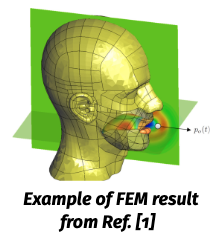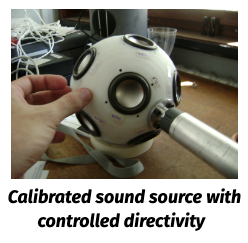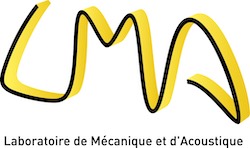Duration : 6 months full-time (between February and August 2023)
Location : Laboratory of Mechanics and Acoustics, Marseille, France
Compensation : Yes, in accordance to the French law (about 600€/month)
Context : The internship offer is part of the ANR-funded RAYOVOX project aiming to develop an instrumentation to jointly characterize voice radiation (in near and far fields) and vocal tract internal acoustics, the former being the subject of the present offer.
Voice production relies on three major functional stages : 1/ at the thoracic level, air
is expelled from the lungs, 2/ within the larynx, a flow-structure instability induce the
onset of vocal folds vibration and of sound waves generation, 3/ those waves propagate into the vocal tract whose geometry and acoustical resonances characteristics are
controlled by the articulators (jaw, tongue, lips, velum). Larynx biomechanics and vocal
tract articulation have been extensively studied over the last half century.
 On the contrary, data about the voice radiation patterns is still pretty sparse. On the
modelling side, recent work based on Finite Element computations investigated the influence of simplifications of the face geometry on the radiation impedance seen by the
vocal tract [1] or the effect of nonplanar modes in the vocal tract. Directivity diagrams have essentially been pro-
duced with hemi-circular antennas in 2D vertical and horizontal planes, or with spherical antenna with a coarse
angular resolution. The aim of the project is to enable the experimental fast estimation of both radiation impedance and 3D directivity diagrams with the help of the concept of acoustical radiation modes (ARM). Introduced in the 1990 by Borgiotti [2] and Cunefare [3], these ARM are designed to propose a basis for the distribution of
velocity on the source surface with a special attention to radiation efficiency.
Calibrated sound source with
controlled directivity.
On the contrary, data about the voice radiation patterns is still pretty sparse. On the
modelling side, recent work based on Finite Element computations investigated the influence of simplifications of the face geometry on the radiation impedance seen by the
vocal tract [1] or the effect of nonplanar modes in the vocal tract. Directivity diagrams have essentially been pro-
duced with hemi-circular antennas in 2D vertical and horizontal planes, or with spherical antenna with a coarse
angular resolution. The aim of the project is to enable the experimental fast estimation of both radiation impedance and 3D directivity diagrams with the help of the concept of acoustical radiation modes (ARM). Introduced in the 1990 by Borgiotti [2] and Cunefare [3], these ARM are designed to propose a basis for the distribution of
velocity on the source surface with a special attention to radiation efficiency.
Calibrated sound source with
controlled directivity.
Objectives : in the sequel of an ongoing student project, the current internship offer focuses on the development and validation of a mixed numerical
and experimental approach for the fast estimation of both radiation impedance and 3D directivity diagrams. The methodology is as follows :
1. Scanning of the 3D geometry of the sound source
2. Conversion of the points cloud into a valid closed surface mesh
3. Computation of the radiation impedance matrix and of the ARM
4. Identification in terms of ARM of a measured acoustic field
5. Estimation of the corresponding directivity pattern
This workflow is to be validated on a calibrated sound source that has been designed to enable controlled directivity and whose radiation modes have already been numerically and experimentally characterised [4].
The intern will focus in :
1. the implementation of this workflow,
2. its experimental validation on the calibrated source.

Master students in acoustic engineering with signal processing knowledge and strong interest for experimental work are welcomed to apply.
Key words : Acoustical radiation, Boundary element method, directivity.
Bibliography :
(1) Arnela et al. J. Acous. Soc. Am 134(4), 2946-2954, 2013.
(2) Borgiotti, J. Acous. Soc. Am. 88, p. 1884-1893, 1990.
(3) Cunefare, J. Acous. Soc. Am. 109, p. 203-2015, 2001.
(4) A. Pasqual, ”Sound Directivity Control in a 3-D Space by a Compact Spherical Loudspeaker Array”. Ph.D thesis,
State Univ. Campinas, Brazil.
More informations about the contexte, bibliography, ...



